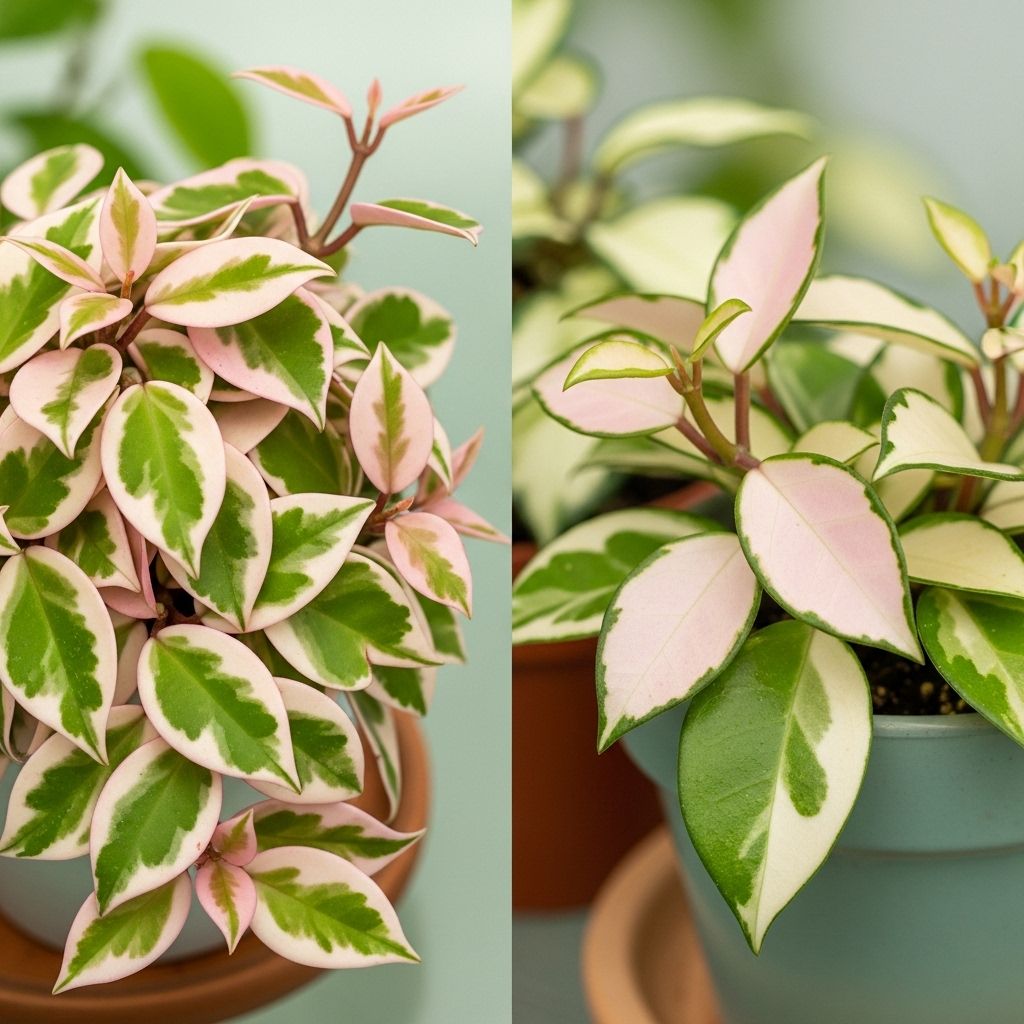Hoya Krimson Queen vs Princess: Ultimate Guide to Wax Plant Varieties
Discover leaf patterns and growth traits to find the ideal wax plant for your home.

Image: HearthJunction Design Team
If you’re searching for beautiful, low-maintenance, and striking houseplants, Hoya Krimson Queen and Hoya Krimson Princess top the list for many indoor gardeners. These vining wax plants, with their bold variegation and delicate blooms, bring a touch of exotic charm and lush greenery to any interior space. But how do you tell them apart, and which is right for your plant shelf? In this comprehensive guide, we’ll explore all aspects of Hoya Krimson Queen vs Princess—from appearance and origin to care requirements and frequently asked questions.
What is a Hoya?
Hoyas are members of the dogbane family (Apocynaceae), a diverse group of over 500 species native to tropical and subtropical Asia and Australia. Known by common names such as wax plant, waxvine, and waxflower, Hoyas are renowned for their glossy, sometimes succulent-like foliage and clusters of star-shaped, waxy flowers. Originally discovered by botanist Robert Brown in the 1840s, the genus was named in honor of Thomas Hoy, a gardener and botanist friend of Brown’s.
In the wild, many hoyas are robust climbers, sending their vines up tree trunks or trailing across rocky outcrops. Some species can reach staggering lengths of nearly 60 feet in their natural rainforest environments. Indoors, they’re primarily cultivated as trailing or climbing houseplants, beloved for both their decorative foliage and resilient nature.
Meet the Contenders: Hoya Krimson Queen and Krimson Princess
Both Hoya Krimson Queen and Hoya Krimson Princess are cultivars of the classic Hoya carnosa species, differentiated largely by their unique variegation and subtle differences in growth habits. Let’s break down their similarities and distinctions in detail below.
Table: Key Differences Between Hoya Krimson Queen and Princess
| Feature | Hoya Krimson Queen | Hoya Krimson Princess |
|---|---|---|
| Leaf Variegation | Green center, white/pink margins | Cream/pink center, green margins |
| Leaf Texture | Thinner, more textured, less waxy | Thicker, more succulent-like |
| Stem Color | Brownish | Pinkish-red |
| Growth Rate | Faster | Slower |
| Mature Height (indoors) | Up to 7 ft | Up to 4 ft |
| Bloom Color | Pale pink | Reddish-pink |
Appearance: Coloring, Leaves, and Stems
Leaf Variegation
- Krimson Queen: Features bold green leaf centers surrounded by white or pink margins. This border-style variegation gives the Queen its distinct look.
- Krimson Princess: Displays creamy/pink centers edged by dark green margins. The variegation is often more pronounced in bright, indirect light, where new growth may develop a pink hue.
Leaf Texture and Size
- Krimson Queen: Leaves are more textured and not quite as waxy compared to the Princess. The leaf surface is slightly thinner and often feels less succulent to the touch.
- Krimson Princess: Leaves are much thicker, shorter, and have a very fleshy, succulent-like appearance. They typically grow to about 3–4 cm in length.
Stem Color
- Krimson Queen: Stems are usually brownish in tone.
- Krimson Princess: Stems have a pinkish-red cast, especially in new growth areas.
Growth Rate and Habit
The way these two Hoyas grow is influenced by their variegation and corresponding chlorophyll content.
- Krimson Queen: Thanks to more green (and thus more chlorophyll for photosynthesis), the Queen is a faster grower. Indoors, it can reach up to 7 feet, and in the wild, potentially 25 feet or more.
- Krimson Princess: With less green, the Princess grows more slowly, topping out at about 4 feet indoors and between 15–18 feet outside.
Both are vining plants capable of trailing or climbing with support, making them ideal for hanging baskets or trellis-trained houseplants.
Flowers and Fragrance
Both varieties produce the iconic waxy, star-shaped inflorescences typical of the Hoya genus:
- Krimson Queen: Produces clusters of small pale pink flowers, often with a subtle sweet fragrance.
- Krimson Princess: Bears reddish-pink blooms, sometimes with a more vivid hue compared to the Queen.
The flowers generally appear in late spring or summer, especially when the plant is mature and receiving enough light and humidity.
Native Origin and History
Both Krimson Queen and Princess originate from the species Hoya carnosa, which is native to East Asia and Australia. In their natural habitat, Hoyas are epiphytic or lithophytic, rooting in the crevices of trees or rocks in humid, tropical forests.
Plant Care Comparison: Krimson Queen vs Princess
While these plants have similar care needs, slight differences exist, especially regarding light and water due to variegation and leaf thickness.
Light Requirements
- Both: Prefer bright, indirect light. Too little light results in loss of variegation; too much direct sun can scorch leaves.
- Krimson Princess: May develop improved variegation or a pink flush in new growth with slightly brighter indirect light.
Watering
- Both: Require well-draining soil and like to dry out slightly between waterings. Overwatering is a common cause of root rot.
- Krimson Princess: Thicker, more succulent leaves allow it to tolerate slightly drier conditions than the Queen.
- Krimson Queen: May need a bit more water, as its thinner leaves lose moisture faster.
Humidity and Temperature
- Both: Thrive in moderate to high humidity (ideally 70–80%) and temperatures between 61°F–95°F (16°C–35°C).
- Both are tolerant of typical household conditions but benefit from added humidity and warmth, especially during active growth and blooming.
Soil and Fertilization
- Well-drained, chunky soil mix (such as orchid bark, perlite, and peat) is best.
- Feed with a balanced, diluted houseplant fertilizer during growing season for best results.
Choosing Between Krimson Queen and Princess
Your choice will come down to personal preference and indoor conditions:
- Krimson Queen: Ideal if you want a fast-growing, reliable vining plant with elegant green-centered foliage and easier bloom potential.
- Krimson Princess: Perfect for those who prefer more dramatic, creamy-centered variegation and a succulent-like plant that can handle occasional drought.
Both are equally beautiful and easy to care for—making them excellent additions to any plant collection.
Frequently Asked Questions (FAQs)
What is the main difference between Hoya Krimson Queen and Princess?
The most obvious distinction is the leaf variegation: Queen has green centers with white/pink margins; Princess has cream/pink centers with green margins. They also differ in growth rate, stem color, and leaf thickness.
Which Hoya grows faster?
Hoya Krimson Queen generally grows faster due to increased chlorophyll (more green area), which boosts its ability to photosynthesize and produce energy for growth.
Can Krimson Queen and Princess be grown together?
Yes! Both require similar care, so they can share the same shelf or hanging basket for a vibrant, contrasting display.
How do I encourage my Hoya to bloom?
- Provide bright, indirect light and sufficient humidity.
- Allow the plant to become slightly root-bound and avoid frequent repotting.
- Feed during spring and summer with a balanced, diluted fertilizer.
Do Hoya Krimson Queen and Princess have any special humidity needs?
While both will tolerate household humidity, they thrive in higher humidity (70–80%), which helps prevent leaf edges from browning and encourages blooming.
Are these Hoyas safe for pets?
Most Hoya species are considered non-toxic to pets, making them a safe and stylish addition for homes with animals. However, always check for up-to-date guidance on plant safety for your specific pets.
Styling Ideas and Display Tips
- Place in hanging baskets to show off trailing vines and cascading foliage.
- Train vines on a trellis or moss pole for an eye-catching vertical display.
- Pair Krimson Queen with Krimson Princess for contrasting variegation in one arrangement.
- Feature in bright bathrooms or kitchens where humidity is naturally higher.
Conclusion
Whether you’re drawn to the white-margined elegance of Krimson Queen or the creamy-centered drama of Krimson Princess, both Hoyas promise to bring lush, tropical beauty and straightforward care to any indoor garden. Buy them both to enjoy a dynamic, ever-changing tapestry of leaves and blooms, or select the one whose growth and color patterns best complement your space and care style.
References
Read full bio of Srija Burman












